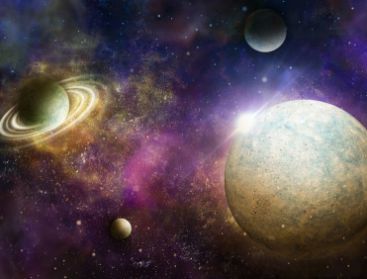
Extreme forms of life could exist on eccentric planets outside the solar system with conditions unlike those on Earth, U.S. scientists say.
Extreme exoplanets, from scorching hot worlds with molten surfaces to frigid ice balls, could maintain some form of life even though they don't inhabit a star's so-called habitable or "Goldilocks" zone, they said.
"When we're talking about a habitable planet, we're talking about a world where liquid water can exist," said Stephen Kane, a scientist with the NASA Exoplanet Science Institute at the California Institute of Technology in Pasadena. "A planet needs to be the right distance from its star -- not too hot and not too cold."
Not all exoplanets have Earth-like orbits that remain at a fairly constant distance from their stars.
Astronomers have identified many planets that travel in very oblong, eccentric orbits that vary greatly in distance from their stars.
"Planets like these may spend some, but not all of their time in the habitable zone," Kane said in a release from NASA's Jet Propulsion Laboratory in Pasadena. "You might have a world that heats up for brief periods in between long, cold winters, or you might have brief spikes of very hot conditions."
While those conditions are very different from Earth's, this might not preclude them from being able to support alien life, Kane said.
"Scientists have found microscopic life forms on Earth that can survive all kinds of extreme conditions," he said. "Some organisms can basically drop their metabolism to zero to survive very long-lasting, cold conditions.
"We know that others can withstand very extreme heat conditions if they have a protective layer of rock or water. There have even been studies performed on Earth-based spores, bacteria and lichens, which show they can survive in both harsh environments on Earth and the extreme conditions of space."
The habitable zone around stars might be larger than once thought, the researchers said, and planets that might be hostile to human life might be the perfect place for other, more extreme forms of life.
"We may find some surprises out there as we start to determine exactly what we consider habitable," Kane said. (UPI)
The habitable zone around stars might be larger than once thought, the researchers said, and planets that might be hostile to human life might be the perfect place for other, more extreme forms of life.
"We may find some surprises out there as we start to determine exactly what we consider habitable," Kane said. (UPI)
<관련 한글 기사>
지구랑 전혀 다른 외계행성에서 생명이?
지구와 전혀 다른 환경의 외행성 (태양계 바깥의 행성)에서도 생명이 존재할 수 있다는 주장이 제기되었다.
지금까지는 지구와 같이 항성으로부터 ‘적당한’ 위치에 있어 너무 뜨겁거나 차갑지도 않은 이른바 ‘골디락 지역’에서만 생명이 존재할 수 있다고 생각되어 왔다.
그러나 캘리포니아 공과대학에 있는 미국 항공우주국 (NASA: 나사) 외행성 연구소의 과학자들이 최근 밝힌 바에 따르면 극단적인 환경을 지닌 행성에서도 생명이 존재할 가능성이 있다고 한다.
천문학자들은 최근 항성으로부터 굉장히 긴 곳까지 공전하는, 극단적으로 긴 타원형의 궤도를 가진 행성을 여러 개 발견했다.
외행성 연구소의 스티븐 케인은 이러한 행성들이 ‘서식가능’ 지역에서 어느 정도 시간을 보낼 수도 있다고 말했다. 그는 이러한 환경이 지구와는 매우 다르지만 그렇다고 해서 생명이 존재할 가능성이 아예 없어지는 것은 아니라고 덧붙였다.
“지구에 있는 미생물들의 경우 극단적인 환경에서 살아남는 경우가 있습니다. 일부 유기체들은 매우 오랫동안 지속되는 추위에 견디기 위해 신진대사를 사실상 ‘0’에 가깝게 떨어뜨리는 경우도 있죠”라고 케인은 말했다.
“그 외에도 바위나 물로 이루어진 표면 아래에서 몸을 보호할 경우 굉장히 높은 온도에서도 생존할 수 있는 생명체도 있습니다. 또한 지금까지 시행된 연구결과를 보면 포자나 박테리아, 이끼 등은 지구에서뿐만 아니라 우주의 가혹한 환경에서도 살아남을 수 있다는 것이 확인되었습니다”라고 그는 덧붙였다.
이러한 점을 종합해보면 생명체가 살 수 있는 환경은 생각보다 많을 수 있다고 과학자들은 말했다. 또한 인간이 살기에 적합하지 않은 행성의 경우에도 전혀 다른 형태의 생명이 살기에는 적합할 수 있다고 한다. (코리아헤럴드)







![[Graphic News] Number of coffee franchises in S. Korea rises 13%](http://res.heraldm.com/phpwas/restmb_idxmake.php?idx=644&simg=/content/image/2024/05/02/20240502050817_0.gif&u=)









![[Eye Interview] 'If you live to 100, you might as well be happy,' says 88-year-old bestselling essayist](http://res.heraldm.com/phpwas/restmb_idxmake.php?idx=652&simg=/content/image/2024/05/03/20240503050674_0.jpg&u=)
